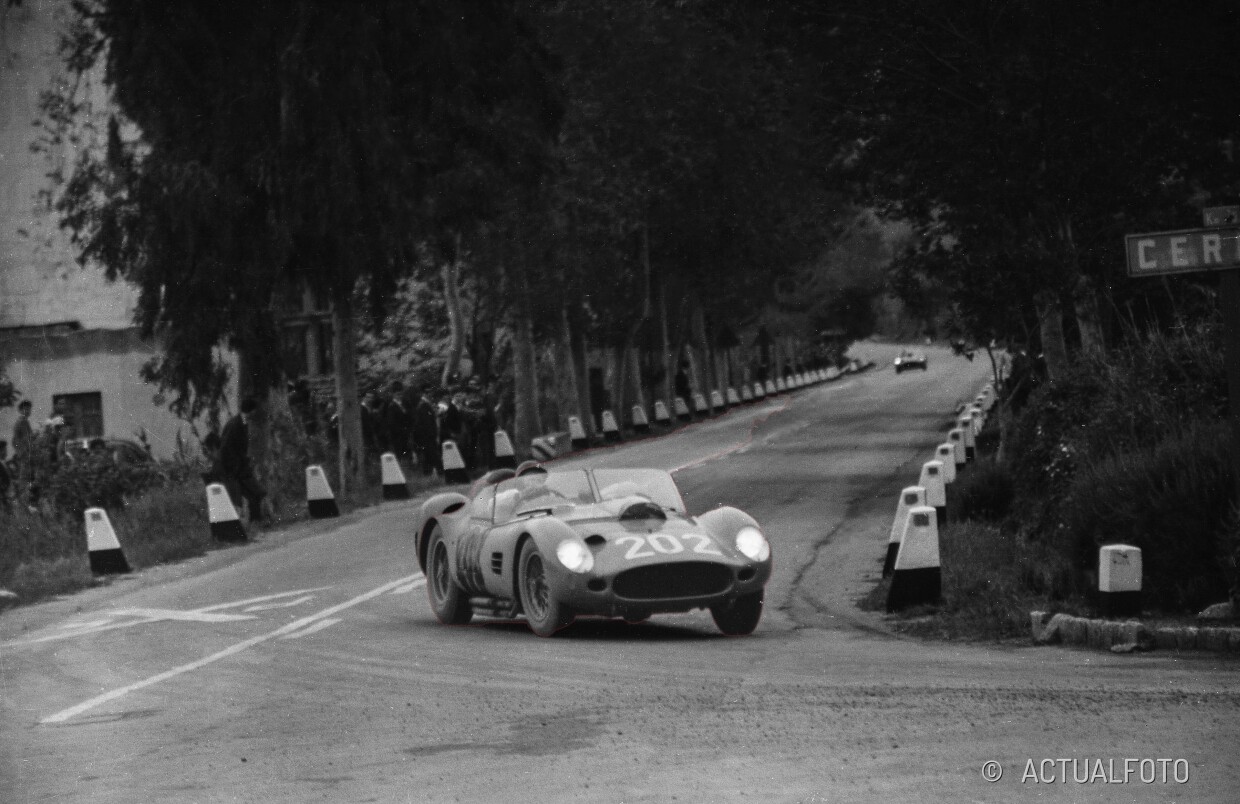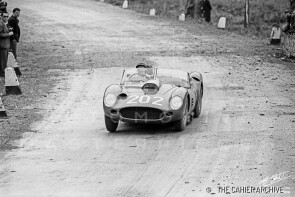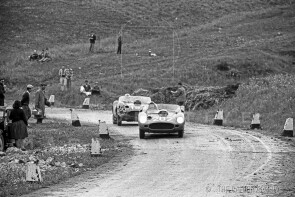
1959 Ferrari 250 TR 59/60
ON/OFF
Why am I an Automotive Masterpiece?
The Ferrari 250 is a series of sports cars and “granturismo” built by Ferrari from 1952 to 1964. The company's most successful early line, the 250 series includes many variants designed for road use or sports car racing. 250 series cars are characterized by their use of an engine designed by Gioacchino Colombo, with the exception of the 250 Europa. This engine was the “Tipo 125” with a displacement of “just” 2953 cc, but it was light and powerful. The 250 series was replaced by the 275 and 330 series cars.
The 250 TR (Testa Rossa) model was introduced on November 22, 1957, in Maranello. The name "Testa Rossa" originates from the distinctive red color of the valve covers. Ferrari entrusted this car with its fortunes in the Sport category. In the competitions of this category, the 250 TR, constantly updated, was a true star until 1962, collecting an incredible sequence of victories and becoming one of the most glorious Ferraris in the brand's history. The birth of the 250 TR can be traced back to the spring of 1957, when the first prototype (chassis no. 0666) was tested in races like the Nurburgring 1000 Kms. It was a modified version of the 290MM, laying the groundwork for the final model introduced in November of the same year. Compared to previous Sport models, all equipped with engines over 3 liters, the 250 TR had a 3-liter 12-cylinder engine derived from the 250 GT under the hood. This was because, starting in 1958, the sports regulations required Sport cars to have engines within 3 liters. The "Colombo" V12, in this version, developed around 300 horsepower, which, thanks to a weight of only 800 kg, allowed for speeds of up to 270 km/h. The aluminum barchetta body was designed by Sergio Scaglietti with a characteristic "pontoon fender" design to improve cooling for the front brakes. Aesthetically, the 250 TR resembled the 500 TR but had a longer wheelbase, extended to 2350 mm. The need for height clearance for the intake trumpets of the six twin-barrel Weber carburetors required a bulge on the hood. After debuting quietly, the 250 TR officially appeared at the 1957 24 Hours of Le Mans, with a car entrusted to the driver duo Gendebien and Trintignant, though it retired due to a mechanical failure. However, the real first racing season was in 1958, filled with successes. The team of Phil Hill and Peter Collins triumphed at the 1000 km of Buenos Aires and the 12 Hours of Sebring, ahead of other TRs. Musso and Gendebien won the Targa Florio, and Gendebien also won the 24 Hours of Le Mans with Phil Hill. In 1959, Ferrari introduced significant updates to the 250 TR, including chassis modifications, an off-center engine installation to improve weight distribution, a new five-speed gearbox, and Dunlop disc brakes. The body was also revised to enhance aerodynamics, with Pininfarina creating a more homogeneous shape, constructed by Fantuzzi. Despite these changes, the "250 TR 59" had a troubled season, winning only the 12 Hours of Sebring. Aston Martin and Porsche dominated the remaining major races that year. The car redeemed itself in 1960 with the "250 TR 60" version, featuring further refinements and, in some cases, independent rear suspension (TRI 60) and/or a six-speed gearbox. The updates were aimed at making it more competitive and complying with the new requirements of the 1960 CSI regulations, appendix C. The mechanical updates were as follows: the wheelbase was shortened from 2320/2350 mm to 2280 mm. The front engine was moved back and lowered. The gearbox was available in different versions, with front or rear mounting, and offered 4 or 5 gears. As for the bodywork, the hood was extended to the windshield, and the driver’s air vent was integrated into the hood. The oil filler cap was moved near the windshield. The windshield gained wider central and side pillars. A single or double "cone-shaped" side air intake appeared on the hood. The left-side air vent remained unchanged but was partially obstructed by the oil tank. There were also updates at the rear: the hood was made wider and longer; the fuel filler, previously located on the hood, was moved to the upper part of the headrest, which extended to the end of the hood. Air vents were added on both wheel arches. To meet the regulatory requirements, the low windshield was replaced with a taller one (at least 34 cm), spanning the entire width of the car; a mandatory windshield wiper was added, and a luggage compartment appeared. With these upgrades, the car remained extremely competitive until 1962. The victories in 1958 and 1960 earned Ferrari triumphs in two World Sports Car Championships, while 1961 was won by its evolution, the "250 TR 61." The Ferrari 250 TR is the only car to have won the 24 Hours of Le Mans three times during this era, including a historic win in 1960 led by Olivier Gendebien and Paul Frère. Across all variants, it is reported that only 34 examples were built, each representing a unique chapter in Ferrari's racing history.
The Ferrari 250 TR 59/60, chassis no. 0772, is part of a select group of five "Testa Rossa" cars. To counter the fierce competition from rivals, engineer Chiti decided to develop a 250 TR exclusively for the Scuderia Ferrari team, without the compromises of private clients' demands and requirements. For 1959, only five of these short-wheelbase TR 59 examples were produced for the Scuderia, fitted with the innovative body designed by Pininfarina and built by Medardo Fantuzzi (out of 34 total 250 TRs, only 10 were bodied by Fantuzzi). These five cars were produced in two batches; the first three, chassis no. 0766, 0768, and 0770, were completed in January/February 1959, and the last two, chassis no. 0772 and 0774, in April. Chassis no. 0772 debuted as part of Ferrari's strategy to maintain dominance in the highly competitive field, especially in light of challenges posed by rivals like Maserati and Aston Martin. It was initially conceived as a development platform, performing tests and experiments during 1959, although it never officially entered a race that year. In 1960, the last three (chassis no. 0770, 0772, and 0774) were revised and updated to the new specifications required by the sporting regulations, creating the TR 59/60 model, which would be used by the Scuderia for the new season. These three were joined by two cars equipped with independent rear suspension (TRI 60). The Ferrari 250 TR 59/60, chassis no. 0772, is therefore one of the two "official" Scuderia Ferrari TR 59 cars, completed in April 1959, with a Pininfarina body built by Fantuzzi. In preparation for the 1960 season, this chassis was subjected to significant mechanical upgrades, including a refined powertrain and adjustments to its suspension for improved handling on various tracks. It appears to have been used for experiments, tests, and as a reserve chassis. There is no record of it racing in 1959. For 1960, it was updated to TR 59/60 and destined for racing. On its debut at the Targa Florio, driven by Richie Ginther, it had an accident. During the trials, some Ferraris had numbers painted on their bodies that were deemed too small to be seen on the winding course. It was therefore requested to repaint the numbers in a larger size; this was the case for chassis no. 0772 with race number #202.Of the 15 Ferraris entered in the race, only 4 were official entries, and 0772 was the only one of the two TRs to have actually competed in the race. The car participated with the crew of Cliff Allison - Richie Ginther, as well as Giulio Cabianca (registered) - Lodovico Scarfiotti (registered). The car was having a great race when, according to reports, it collided with a tree during the 6th lap, forcing it to retire. There are no images documenting the incident on-site. The only known post-race image of car #202 is believed to be the one showing it on a car transporter in front of the Jolly Hotel in Cefalù, visibly damaged on the front left side. Due to the severity of the damage, there was not enough time to repair the car for the Le Mans race so, it is believed that Scuderia Ferrari decided to temporarily mount engine 0772, which had been registered, authorized, and stamped for the race, onto chassis 0774, thus allowing it to compete. Assuming this hypothesis is plausible, the car with chassis 0774 and the engine from the ill-fated 0772 not only participated, but went on to an overall win in the 1960 edition of the 24 Hours, finishing four laps ahead of another TR from N.A.R.T. Following this race, chassis no. 0774 reverted to the original 0774 engine that is still fitted today. The identification of chassis no. 0772 and its history were a challenging task, considering the extreme similarity between the three cars chassis no. 0770, 0772, and 0774. Only after careful research were the distinguishing elements between the three cars identified, by analyzing photographs taken during competitions just before and after the 1960 Targa Florio. Distinctive features found on both no. 0772 and no. 0774 include: the perspex cover over the intake trumpets, secured with 6 rivets on each side; and the bulge on the left-upper side of the engine hood, located between the aforementioned cover and the left hood strap. The elements that distinguish chassis no. 0772 are: the position of the Scuderia Ferrari logo, located on the side, at the edge of the front side air intakes; on the left side, to the left of the oil filler door. Alignment of the bottom edge of the door, on both sides of the car, with the lower edge of the front-side air intake. Taking the height of the upper section of the side air intake as a reference, the distance between the door and the intake itself will be twice the width of the intake. The dimensions of the engine air intake with the "short cone": the top of the "cone" of the intake, positioned to the right of the hood, is aligned with the lower edge of the hood itself. The top of the water filler door is very close to the lower edge of the engine hood. From these elements that distinguish it from the other two cars (chassis no. 0770 – 0774), photographed during the race before and after the Targa Florio, we can deduce that the car with race number #202, which appeared at the Targa Florio, is chassis no. 0772.





